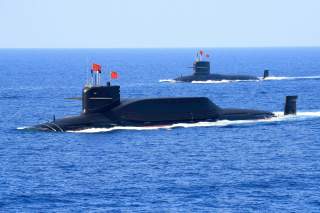We've Got the Details on China's Submarine Drones
The real deal?
Key point: America and China are both rushing to build robots to fight each other's neighbors.
China may soon have a new weapon to help defend itself against enemy submarines.
For years, many have commented on Beijing’s lack of anti-submarine warfare (ASW) capabilities. The Department of Defense’s 2016 report on China’s military, for instance, noted that Beijing “continues to lack either a robust coastal or deep-water anti-submarine warfare capability.”
This was not a major problem when China’s naval strategy was largely aimed at denying adversaries access to its coastlines. In recent years, however, the People’s Liberation Army Navy (PLAN) has begun deploying bigger, more advanced ships as it pushes to become a blue water navy. These ships also make great targets for enemy submarines—something that hasn’t gone unnoticed among China’s neighbors and the United States—creating a greater urgency for Beijing to strengthen its ASW capabilities.
One component of this can be found in a new article by the Hong Kong-based South China Morning Post. On July 22, the SCMP reported, citing Chinese artificial intelligence (AI) researchers, that “China is developing large, smart and relatively low-cost unmanned submarines that can roam the world’s oceans to perform a wide range of missions.” One of these missions is almost certain to be ASW.
The report said that the robot submarines are not intended to fully replace manned submarines. And, at least for now, they will not make entirely autonomous attack decisions. That is, a military officer must approve whether to attack another ship.
Still, the article noted that “the robotic subs are aimed particularly at the United States forces in strategic waters like the South China Sea and western Pacific Ocean.”
China already has small unmanned underwater vehicles (UUVs). These are severely limited, however. Besides having limited range and payload capabilities, they are launched from another ship or submarine.
The researchers who talked to SCMP noted the new robotic submarines—which China hopes to deploy by 2021, the one-hundred-year anniversary of the Chinese Communist Party—are much larger and more autonomous.
“They station in dock as conventional submarines,” the report said. “Their cargo bay is reconfigurable and large enough to accommodate a wide range of freight, from powerful surveillance equipment to missiles or torpedoes.”
The larger boats are also powered by diesel-electric engines and other sources that give them greater endurance.
One of the most attractive features of AI-enabled submarines is their low cost. As the SCMP article notes, manned submarines must have a high level of stealth to ensure survival, while also taking care of various safety and comfort level issues for its submariners.
These AI boats won't have to worry about many of these issues. Thus, China can build and deploy a lot of them to perform reconnaissance missions, target other submarines or surface ships, and even possibly to ram into other ships. This will be especially useful in waters near China where the boats can be programmed and learn to operate in the familiar terrain.
Recommended: Forget the F-35: The Tempest Could Be the Future
Recommended: Why No Commander Wants to Take On a Spike Missile
Recommended: What Will the Sixth-Generation Jet Fighter Look Like?
One curious part of the SCMP report is the sudden transparency. The People’s Liberation Army has a well deserved reputation for opacity in military developments. Yet, this article interviewed Lin Yang, a chief scientist at 912 Project—a “classified” program to develop the AI-enabled submarines—on the record.
As Elsa B. Kania, an expert on Chinese AI and defense innovation at the Center for a New American Security, noted on Twitter, “That [a] senior [scientist] is willing to discuss a *classified* military program for an English-language publication surprises me. Assuming that Lin Yang is not about to be charged under China’s National Security or Counterespionage Laws, he must have received official permission.”
Kania makes the case that this permission was likely granted for signaling purposes, and could enhance Chinese deterrence. At the same time, she notes it is nearly impossible to confirm the level of maturity or actual capabilities of these submarines. It is therefore possible China is revealing details about this program to make it seem more advanced than it is in reality.
Still as Kania pointed out elsewhere, “The PLA recognizes a potential opportunity to undermine current U.S. dominance in undersea warfare.” In that regard, it is interesting to note that the Department of Defense’s latest annual report on China’s military did not mention Beijing’s relative weakness in ASW, and China has been taking various steps to strengthen its ASW capabilities.
Zachary Keck (@ZacharyKeck) is a former managing editor of the National Interest. This first appeared in July 2018.
Image: Reuters

